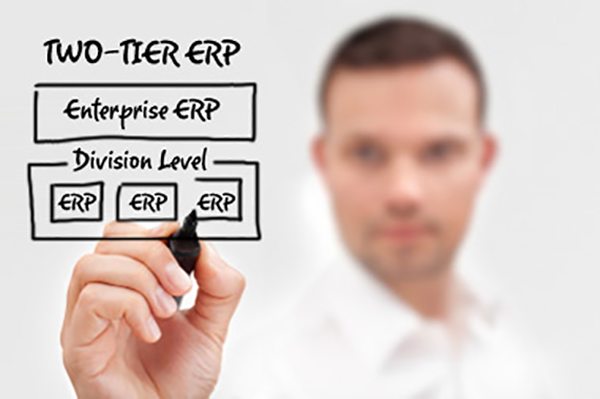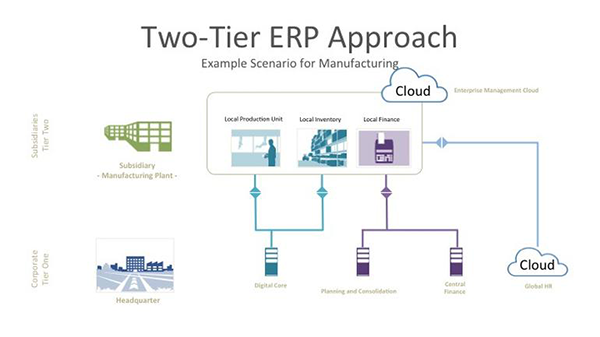Many companies struggle with the right approach for running an Enterprise management system in their headquarters – and what to run then in a subsidiary, division, a merger, or divestment. Let’s see what a successful approach could be.

Two-Tier ERP – finally the best of both worlds?
Many companies still have a patchwork of ERP solutions across their business. Rationalizing these applications can deliver economies of scale via global standardization, while leveraging the cloud for faster adoption. In this first article in a new series, I will discuss the two-tier ERP approach and how a modern Enterprise management solution can support and improve this often complex model.
Global organizations are increasingly adopting a two-tier enterprise resource planning (ERP) strategy. Two-tier ERP is the practice of running a deployment model to serve the requirements of both the headquarters and the subsidiary – in other words, one at the corporate level (to handle more complex business requirements), and one at the plant, division, or subsidiary level (usually a lighter solution focused specifically on the requirements of small subsidiaries). The corporate level uses a traditional broader solution that acts at a system of record and standardizes processes for Finance, HR, and Logistics etc. The subsidiary deploys a ‘lighter’ ERP solution to address their specific requirements with greater flexibility and agility often from a different vendor than the headquarters.
The Plus side of a Two-tier ERP Model
Organizations that adopt a two-tier approach stand to gain a number of benefits. Let’s run through the most significant of these:
Lower costs
Implementing a lighter ERP solution in the subsidiaries reduces the associated implementation and upgrade costs for IT. This cost reduction increased with a cloud deployment in the subsidiary via the associated shift of costs from capital expense to operational expense.
Agility
In many cases, the ability for a subsidiary to be able to react quickly to the market is a make or break requirement. Tier 2 ERP solutions deployed in the subsidiary are easier and quicker to configure and change as subsidiaries change. With a two-tier deployment, the ERP system is controlled and run by the subsidiary as opposed to a top-down IT governance from the headquarters. While this approach provides transparency to the headquarters, it can significantly slow down a subsidiaries ability to react.
Improved Innovation
With the backdrop of a rapidly transforming digital market, companies must continually adapt to new threats and opportunities and so they must continue to innovate. Tier two applications in the subsidiaries can be quickly customized to better suit the needs of the subsidiary allowing them to better react to the local market requirements. If the tier two system is a SaaS solution, then innovation is delivered and adopted on a much more frequent basis and driving this advantage further.
Adoption
Traditionally, adoption of ERP systems within the subsidiary is low with larger ERP deployments. These are often targeted at the headquarter requirements first and can be challenging to use with the less complexity required in the subsidiary. Tier 2 cloud solutions utilize modern user interfaces and provide good usability for the subsidiary, to drive up adoption.
However, while the advantages above are all valid, it is worth noting that with different vendor solutions in the headquarters and subsidiaries, there comes the burden of integration and challenges of running two systems, with two separate data models. These are not small challenges to overcome and some of the benefits identified above are offset with the cost and time to integrate and subsequently change/evolve the two systems in parallel.

Dawn of a new era with semantic compatibility?
With the launch of modern in-memory based solutions that fit headquarter requirements – which are usually Large Enterprises – AND smaller entities like subsidiaries, merger & acquisition cases, or even divestments – which are usually upper mid-market size and definitively do prefer a SaaS model. Customers can benefit from a real time, in-memory system that offers instant insight as well as re-imagined and simplified business processes – across the entire spectrum of the business. The best case is if those systems can be offered as both an on premise and as a SaaS solution, sharing the same semantic and data model. This means that for the first time, at both the headquarter and the subsidiary level can not only benefit from a modern ERP solution designed for the digital economy and a true 2 Tier ERP approach, but also take advantage of a two tier deployment approach, without the known integration limitations – this is a real best of both worlds approach.
If we take the scenario of a headquarter running the on premise solution that then selects SaaS/Cloud to run in the subsidiaries via the two-tier ERP approach; the shared semantic framework provides a number of inherent advantages.
Given the solution knowledge and skills already existing within the company and the reduction in time required to align data models and semantics between the two solutions, there is a much quicker time to value for the subsidiaries and a significant reduction in IT costs associated with the implementation and roll out.
The compatible solutions offer a consistent user interface across both the cloud and on premise versions. This simplified user experience enables high adoption of the solution within the subsidiary for all users, but also significantly reduced onboarding and change management requirements for roles that work closely with the headquarter, e.g. Finance, Manufacturing, etc. where the user experience and the look and feel across solutions is consistent.
To summarize, the advantage of a two tier ERP deployment are significant, but traditionally have come with a time and cost burden to integrate both the headquarters and subsidiary solutions to ensure both data and semantic model consistency. The emergence of a modern ERP solution, that shares a semantic and data model across on premise and cloud versions finally reduces this integration barrier of the two-tier ERP model and offers a best of both world approach.
I will further explore some of these topics in more details in this continuing series and will be looking specifically at the business values and advantages of the two-tier ERP deployment model with compatible solutions that offer choice.
Author: Sven Denecken for ÜberTech



